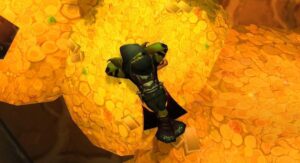
How to Make Gil in FFXIV
Making Gil in FFXIV can be accomplished in various ways, from crafting and gathering to selling event rewards and gear on the market board. Selling your merchandise on this market board may also prove effective.
Completing Tradecraft Level quests is also a fantastic way of earning f14 gil and often yield materials and items which sell well on the Market Board.
1. It’s a game currency
FFXIV is an MMORPG, meaning it features its own in-game currency known as Gil. Players can use this currency to purchase items and services within Eorzea. There are various methods of earning Gil such as completing quests or dungeons; or by participating in its economy by exchanging goods and services with other players.
Earning FFXIV Gil is best done through activities authorized by game developers. These activities may include questing, guildleves, fulfilling duties on the Duty Finder and killing enemies – while crafting or farming can also bring in some extra Gil.
Earning Gil in other ways includes selling loot from Dungeons/FATEs/treasure Caskets/NPCs like Delivery Moogles around settlements; it is also possible to purchase it through third-party websites and players; real-money trading is against EULA/TOS so would lead to their account becoming banned.
2. It’s a resource
Gil is the currency used in Final Fantasy XIV that can be earned through battles, selling unwanted items or questing. Additionally, players can spend it to purchase consumables, equipment and orchestrion tracks as well as saving it with Retainers who will deliver unique items based on quest completion.
As players level up, the amount of FFXIV Gil earned from killing monsters will also increase as players kill more enemies. On Day 7, enemies will drop 1.5x their usual amounts; doubled on Day 10, and three times normal on Day 13. Furthermore, completing a Dungeon, Alliance Raid or Extreme Trial will bring players not only a large sum of Gil but also significant stat enhancements.
Crafting is an excellent way for players to earn Gil, as players can sell equipment, crafting materials and furniture items on the market board. However, this requires an in-depth knowledge of market prices across different servers; therefore it’s advisable to use tools like Universalis in order to monitor this method.
3. It’s a collectible
Gil is the collectible currency used by players in Final Fantasy XIV for purchasing items, services and content in-game. Players can acquire Gil through quests, guildleves, duty roulette and the challenge log as well as by killing monsters and participating in dungeons and FATEs. Players may also make significant amounts of Gil through retainer ventures that grant gear and materials that are in high demand by other players.
While earning currency through gameplay may be rewarding for some players, others may find the process time-consuming and tiresome. To alleviate this issue and enhance gameplay without feeling like they’re grinding for it, many opt to purchase in-game money from third party websites or players in order to gain an edge in competition against those earning it through gameplay; although Square Enix discourages this practice. It may also breach their terms of service agreement but this practice should never be practiced as this would compromise gameplay more quickly and fully than those earning currency naturally through gameplay alone!
4. It’s a reward
Gil can be acquired in various ways in-game, including defeating enemies, completing sidequests and raiding dungeons; however, the most reliable sources are gathering and crafting.
Crafters can quickly earn considerable FFXIV Gil by crafting items and selling them on the Market Board. This method provides an efficient means of earning funds for new gear or Materia when prices for materials rise sharply during content updates.
Hunters can gain a steady source of gil by hunting rare monsters and treasure chests, completing late game quests such as Ancients’ Maze or Unei’s Clan to gain more materials to generate Gil, leveling up their Artisan or taking part in class quests that provide items for Market Committee sale etc.
5. It’s a Currency
As the primary in-game currency, Gil is central to every aspect of Final Fantasy XIV gameplay. From equipping your character for raiding operations or furnishing their homestead in-game, having enough gil is key.
Unfortunately, Eorzea’s most challenging dungeons can make collecting FFXIV Gil an exhausting process that keeps players away from what really interests them in the game. But thanks to reliable sites such as ArmadaBoost that provide safe and secure ways of buying video game currencies without the tedious grind involved with earning them directly; their outstanding customer service ensures an enjoyable purchasing experience so players can return to enjoying themselves and focus on having fun playing!
6. It’s a Game Currency
FFXIV Gil is the primary in-game currency used to purchase equipment, weapons, mounts and other items within the game. FFXIV Gil can be earned through in-game activities such as questing, dungeon crawling, duty roulettes or guildleves.
Players can earn gil by selling goods and services to NPCs, in the Market Board or through player-to-player trading – though selling in-game currency for real money violates Square Enix’s terms of service and can lead to bans. Slaying enemies, completing quests and dungeons provides legitimate ways of amassing gil in-game, providing rewarding experiences while speeding players toward reaching the endgame quickly.
7. It’s a Resource
Gil is an essential in-game resource used for purchasing weapons, equipment, furniture and materials needed for housing. Players can earn it by taking part in quests, guildleves, fulfilling duties on the Duty Finder or selling items on the Market Board; additionally it may be obtained by killing humanoid monsters either in open world environments or during dungeon raids.
Crafting high-demand items such as raid food or glamour gear requires significant time investment; purchasing FFXIV Gil violates both its EULA and Terms of Service as well as distorting the in-game economy with inflation that compromises player experience and community health.



